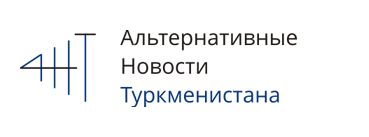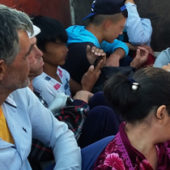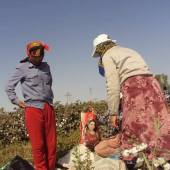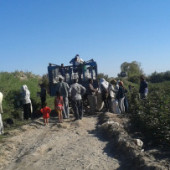 Since the Turkmenistan authorities have introduced unprecedented efforts to block information coming out of the country, especially when it comes to cotton picking (see the new release below), ATN is refraining from publishing photo evidence of the use of forced labor this season, though that does not mean that our monitors have stopped their activities. Instead, we are publishing a photo of produce made in Turkmenistan by a well-known western company. These jeans were made from cotton picked with the use of forced labor. New information from our local monitors shows that the authorities continue the malpractice of forcing civil servants to work in cotton fields. We have informed the appropriate international agencies about specific cases when our independent monitors were pressured (including names, details and particulars for each case).
Since the Turkmenistan authorities have introduced unprecedented efforts to block information coming out of the country, especially when it comes to cotton picking (see the new release below), ATN is refraining from publishing photo evidence of the use of forced labor this season, though that does not mean that our monitors have stopped their activities. Instead, we are publishing a photo of produce made in Turkmenistan by a well-known western company. These jeans were made from cotton picked with the use of forced labor. New information from our local monitors shows that the authorities continue the malpractice of forcing civil servants to work in cotton fields. We have informed the appropriate international agencies about specific cases when our independent monitors were pressured (including names, details and particulars for each case).
***
The practice of forcing civil servants from the municipal, district and regional centers to work in cotton harvesting continued until end November: employees from state-funded and self-financing public enterprises and institutions were obliged either go to the fields, or pay “cotton fees,” or hire replacement workers. Nothing had changed in the ways of securing safety of people who were brought from cities to distant farms and back, and workers were still compelled to take care of their own food, water, shelter (when working long-term), medications, and remedies against poisoning and sunstroke.
The government prevents information leakage
According to ATN sources in Mary, Lebap and Dashoguz regions, for the first time ever, staff from the local police and the Ministry of National Security (MNS) have been mobilized to cotton fields, even though the summoning was not total (unlike for civil servants). Wearing civilian clothes, police and MNS officers joined workers in the fields with the task of preventing the spread of negative information about the use of forced labor in Turkmenistan and detain those who take pictures of harvesters, especially working children.
ATN monitor in the Vekilbazar district of Mary region reported that security forces were not at all interested in exposing falsifications of figures and other fraudulent actions unfolding in front of them. They never responded when a bribed land lessee issued a bogus certificate for harvesting more than two tons of cotton. It was more important for them to detect people collecting information and photos from cotton fields.
Some of these plain-clothed officials followed a bus with cotton harvesters in their own car and later were observing the workers, including using special equipment. Security officers were also among people picking cotton, appearing in front of anyone who took out a mobile phone.
One young forced laborer, for example, wanted to make a selfie at the cotton field, but as soon as he posed for a picture and clicked on the camera, someone grasped his phone and later made the whole group of cotton-pickers hand over their phones for checking.
ATN suspects that these measures against information leakages are the result of last year’s publications about the use of forced labor in Turkmenistan, as these articles attracted human rights organizations and resonated with some famous brands. Several large international companies refused purchasing Turkmen cotton and goods made from it. The authorities took these measures close to the heart, but instead of acknowledging criticism and putting an end to this shameful practice of using forced labor, the government ordered the Ministry of Internal Affairs and the Ministry of National Security to maximize efforts and obstruct any monitoring of the cotton campaign, preventing leakages of information and photos online and pressing criminal charges against those caught “red-handed.”
According to ATN monitors, control was especially stringent in the Lebap and Dashoguz regions.
Contractors or slaves?
This is how the situation was described by a polyclinic worker who in October was harvesting cotton in a Dashoguz region farm:
“The chief doctor and the trade-union committee members told me I had to pick cotton. They never asked me if I wanted to, they just said “you are going.” So what do you call it if not slavery? I cannot quit my job, because I won’t be able to find another, and if I’m lucky enough to find one, it will also have cotton duty. Unlike most of the doctors and many of the nurses, I don’t have spare money to pay for “not going.” Some of my colleagues are sending replacement workers – relatives or unemployed friends – to work in the fields. But most others just pay 20 manats per day to the chief doctor, and he finds the people. The same happens at schools: teachers pay the director who recruits contractors and reports to the Department of Education about the fulfillment of cotton harvesting plans.
All monitors had similar stories about collection points: employees have to gather at 4:30 a.m., so that by 7:00 they could already start picking cotton. Convoys of around 20 buses are accompanied to the fields by a road police car. The buses are packed with workers, many of whom have to stand in the aisles all the way to the field. The police escort the buses to the district centers or distribution points to the local farms. There the townspeople are met by the deputy governor on agriculture, farmers and land owners (formerly government officials who had managed to register as their property huge plots of undisturbed land in Vas and Shahsenem). These officials enter the buses and inspect the workforce, assessing the workers’ capability to work hard all day.
“There were plenty of teenagers, but the officials were reluctant to take them, thinking that they wouldn’t work as hard as it was necessary. All of them wanted to buy a bus with as fewer youngsters as possible. After that the drivers were instructed as to which farm or field they should take the people,” – the polyclinic worker said.
Business and falsification of figures
The cotton campaign gave good opportunities for personal gain to education and healthcare officials.
To avoid being sent to distant and deserted places that lack any kind of infrastructure, teachers prefer to pay 20 manats to their director and forget about the cotton duty – they don’t even need to find replacement workers: everything is arranged by the director who has his own people on standby to work as contractors. The usual price for a replacement worker is 10–12 manats per day, so the rest is pocketed by the director. Thus, the profit from every teacher paying a fee for cotton-picking is 8–12 manats. According to the quota set by the local Department of Education, every day from 15 to 20 teachers are supposed to be sent to the fields.
And this is how figures are falsified. Every bus brings to the field around 40 people. These people are supposed to collect 2 tons of cotton per day, which is 50 kilos per worker. In an ideal situation, when the field is full with open cotton balls and the weather is warm and dry, collecting 2 tons is quite realistic. However, the cotton harvesting period is late autumn, and warm days are rare. Workers often fail to deliver on their daily plan. In such cases group supervisors ask leaseholders for a receipt (containing a bus number, name of the supervisor, date and two-three signatures) that certifies the fulfillment of the 2-tons plan. Some leaseholders are routinely writing such receipts, while others pretend to refuse, and then the workers chip in several manats to “please the soul of the farmer,” as they say.
Monitors from the Lebap region reported that bogus certificates were written not only by leaseholders, but also by foremen or even their bosses.
Sleeping in the fields
Daily harvesting of cotton can hardly be compared to longer trips that imply spending the nights in the fields (for half a month or longer). Long-term cotton pickers are facing much worse conditions than daily workers.
Firstly, they are far away from home, and they have to bring their own folding beds and bedding, as well as food for the first couple of days – for the initial period, until they find a local vendor. For their own money, they buy bread, vegetables and sometimes meat with the local villagers and cook their food on open fire.
Secondly, there are very few buildings with proper living conditions, so workers have to sleep in the open, suffering from mosquitoes at the end of the summer or from night chills in autumn.
Thirdly, they drink water that they can find around. They are lucky if there is a well with clean water, but in many cases there are no sources of water for many miles around – except irrigation ditches alive with microbes, and even if there is another water source, the workers don’t have any transportation to get there.
Leaseholders and farmers think that providing people with drinking water is not their responsibility. “Let them bring water from the city,” – they say.
“So people get sick, almost every day someone complains of stomach ache, vomiting or diarrhea. In Vekilbazar region two women fainted, and one had a nosebleed. With no doctors around, each had to improvise in order to treat themselves,” – ATN monitor reported in November.
Bus stations are markets, and people are for sale
In September and October all bus stations in regional and district centers turned into collection points for cotton field workers. Public buses abandoned their routes, as all vehicles were supposed to bring harvesters to pick seed cotton.
At the collection points, contract workers were being hired. Every day tens of adult men and women, as well as adolescents aged 14–16, offered themselves as workforce. Such a bus station early in the morning resembled a disturbed ant-hill, but in fact, on closer inspection, certain order was in place. Men and women with log-books in their hands made rounds and marked something in their books. These were supervisors from various institutions and public systems. They registered workers and made notes about whether the people worked for themselves or hired replacement workers.
Explicit, uncovered trade was everywhere: workers were bought, payments were cleared. The daily rate in late September and early November was between 10 to 20 manats – depending on the worker’s bartering skills. Everybody tried to hire an adult. Teenagers were rated cheaper, and they were “bought” at the very end. Such human trade also took place during the previous cotton seasons.
The authorities closely monitored all ATN publications on forced and child labor used for cotton-picking, studied the photos, tried to figure out where the pictures were taken, reclaimed lists of workers for the identified farms, and located the people on the photos. Several people were interrogated by special forces to identify those who took pictures of workers, especially children and adolescents.
The publicity surrounding the use of legally prohibited child labor has also brought positive results: the Turkmen authorities started to take measures to prohibit participation of school children in cotton harvesting. ATN sources told about the teacher-parent meetings held at schools before the autumn school break. In the Gorogly, Gurbansoltan Eje and Dashoguz regions directors demanded that the parents forbid their kids to be hired as cotton-pickers throughout the autumn holidays, especially on the Independence Day (27–28 October). Yet, this requirement was mostly ignored, and school children were seen collecting cotton during the holidays.
Authorities have never thanked the people whom they forced into cotton fields, and the rewards were minimal. Moreover, teachers, doctors, culture workers and other employees often heard reproaches from the farmers, like “You haven’t fulfilled the plan!” and “Your cotton is dirty and raw!”. These comments have been used to justify diminished payments, while cheating and falsifying the weight of the collected harvest have become a routine practice.





